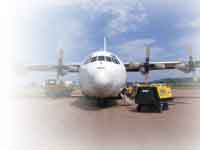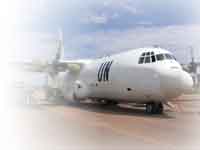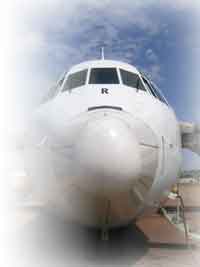|
Introduction & Overview
Lockheed conceived the Hercules during 1951 in response to a USAF requirement for a turboprop tactical air lifter. The first prototype (YC-130 ) flew in August 1954, with the first production example (C-130A) following in April 1955. Of all-metal construction, the Hercules features a high-wing and rear loading doors, which split to form an adjustable height ramp allowing straight-in loading of the cargo compartment.
The low ground clearance of the aircraft allows easy loading/unloading, either manually, by forklift trucks, drive-on vehicles or by use of mechanical systems. Both the cockpit and cargo compartment are pressurised and air conditioned, but the rear doors can be opened in flight to facilitate air-drops. The Hercules was designed to operate from very basic airstrips with minimal ground support and has STOL (Short take-off and landing) capability.
In constant production since 1955, the 2,000th Hercules was delivered to the USAF in May 1992. The vast majority of these aircraft have been for military customers and the type has been acquired by 66 countries. Lockheed has produced five basic military versions of the Hercules, the C-130A, B, E, H and J. The J is an advanced version with new engines, flight deck and systems, but all have the same basic physical appearance. The versatility of the Hercules has allowed its use for many specialised roles, especially by the US military and there are around 40 sub-variants of the basic military models. Lockheed saw potential in the Hercules for civilian applications, but there was little interest from commercial operators during the early years of the programme.
In April 1964, Lockheed flew a commercialised version of the C-130-E called the model 382, which for marketing purposes was referred to as the L-100. All non-commercial equipment was removed from the aircraft, including the navigator's station, so increasing the payload capability, but the aircraft lost none of its versatility.
FAA certificated the L-100 in February 1965. Sales of the L-100 were poorer than expected (Only 22) and during 1967 Lockheed decided to increase the capacity of the aircraft to improve its operating economics. The airframe was stretched 1.52 metres (60 ins) forward of the wing and 1.02 metres (40 ins) aft, a total of 2.54 metres (100 ins), which provided a 20% increase in volume floor space.
The original Allison 501-D22s were replaced by more powerful D22A's which increased cruise speed by 6%. Lockheed claimed a 25% greater productivity potential for this new version which was called the L-100-20. The first -20 was delivered in 1968 and 27th and last in 1981. In October 1969, Lockheed offered yet another stretch of the Hercules, this time adding 2.54 metres (100 ins) forward and 2.03 metres (80 ins) aft of the wing of the L-100-20 to give a 15% increase in volume/floor space. The first L-100-30 flew in August 1970 and was certificated in October.
The -30 proved to be the most popular commercial variant with 63 delivered. Lockheed offered fuselage, stretches for L-100's and L-100-20's. Of the 22 L-100's delivered, 13 were converted to either -20's or -30's and only one L-100 is thought to remain in existence. Six of the 27 L-100-20's delivered were converted to -30 standard. Both L-100, -20 and -30's were delivered to / or have been acquired by military customers. Of the 112 L-100 family deliveries, 26 were to military customers. Lockheed has however offered the L-100-30 with military equipment as the C-130H-30.
Hercules production has now switched to the advanced aircraft, known as the C-130J for the military. Lockheed has also offered a civil version, known as the advanced L-100 freighter, which in addition to the rear loading ramp has the option of a 3.51 metre x 2.74 metre (138 ins x 108 ins) side cargo door forward of the wing on the port side. The usable cross section of the fuselage has also been increased from 3.05 metres (121 ins) to 3.20 metres (126 ins).
Lockheed has not announced any orders for the civil variants, although the
C-130J is being test flown to achieve US FAA civil certification. Although
virtually all commercial Hercules are used as freighters, Merpati of Indonesia operated 2 Lockheed L-100-30 aircraft in an all-passenger configuration.
Crew Requirements The L-100 series requires a cockpit crew of 3, which includes a flight engineer and seating for several others in usually provided in the crew compartment. Cockpit instrumentation in electro-mechanical. The C-130J / advanced L-100 freighter has an all new EFIS flightdeck and can be flown by 2 crew.
Power Plant
The first generation L-100 series is powered by 4 wing-mounted Allison 501-D22 series engines each driving 4 bladed reversible pitch propellers. Two versions of the engine have been applied to the L-100 series:
| Engine |
Power |
Hercules Variant |
| 501-D22 |
3,020skW (4,050shp) |
L-100 |
| 501-D22A |
3,360skW (4,508shp)* |
L-100-20/30 |
* Engine can produce 3,660skW (4910shp), but is de-rated so as not to exceed aircraft's structural capability. The advanced L-100 is powered by Allison 2,100 engines, each driving a 6 bladed, and reversible pitch propeller.
Modifications, Upgrades and Conversions
Lockheed offered fuselage stretches for L-100's to both -20 and -30 standard together with engine upgrades. A fuselage stretch was also offered for L-100-20's to -30's standard. Thirteen L-100's were converted to either -20's or -30's and 6 L-100-20's were converted to -30's.
|
Additional Information:
Aircraft Schematics
Technical Specifications
Payload to Range Ratios






|